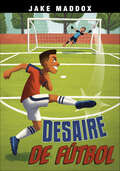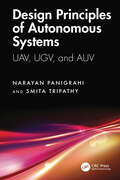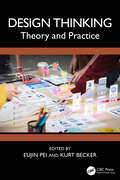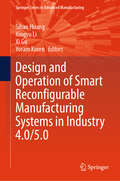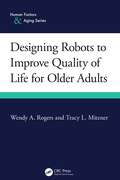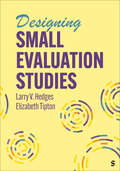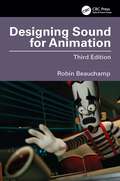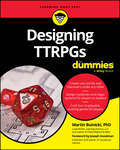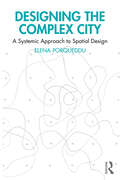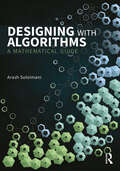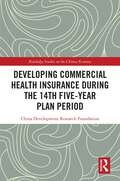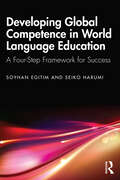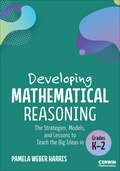- Table View
- List View
Dermoscopy of the Hair and Nails 3e
by Antonella Tosti Andrea SechiThis new edition of a bestselling text almost amounts to a completely new book, with over 750 figures of common and uncommon disorders, including new chapters on trichoscopy of hair transplantation, teletrichoscopy, and trichoscopy of the shaved scalp. The chapters also list the key clues that are important to help the practitioner reach the correct diagnosis about problems with hair or nails."Numerous high-quality photos are helpful in demonstrating key features" (Doody’s Reviews) [of the previous edition]
Desaire de fútbol
by Jake MaddoxDespués de trabajar duro en la temporada baja, Quincy está emocionado de ascender a un equipo de fútbol de primer nivel y jugar con su amigo Will. Pero el resto de sus nuevos compañeros de equipo en los Vipers no están tan entusiasmados. Le dan la espalda a Quincy, lo que le dificulta encontrar su ritmo. Pero pronto, Quincy comienza a ganarse algo de respeto. Entonces su entrenador lo cambia a la alineación titular y mueve a Will al banco. ¿Podrá Quincy encontrar una manera de que Will vuelva al juego? ¿O su amistad flaqueará por el repentino desaire futbolístico? ¡Descúbrelo en este emocionante libro de capítulos fácil de leer de Jake Maddox! After working hard in the off-season, Quincy is thrilled to move up to a top-level soccer team and play with his friend Will. But the rest of his new teammates on the Vipers aren&’t so excited. They give Quincy the cold shoulder, making it difficult for him to find his groove. But soon, Quincy begins to earn some respect. Then his coach shifts him into the starting lineup—and moves Will to the bench. Can Quincy find a way to get Will back in the game? Or will their friendship falter over the sudden soccer snub? Find out in this exciting, easy-to-read chapter book by Jake Maddox!
Design Principles of Autonomous Systems: UAV, UGV, and AUV
by Narayan Panigrahi Smita TripathyThis book explains unmanned systems including Unmanned Aerial Vehicles (UAVs), Autonomous Underwater Vehicles (AUVs) and Unmanned Ground Vehicles (UGVs). It also details system and subsystem compositions and their basic design. The components/subcomponents, employed payloads and sensors, and communication systems used to compose the autonomous system are discussed. It examines generic applications of these unmanned systems including specific missions for which they are employed. Other topics like swarm of drone, anti-drone system, and some algorithms used in navigation and communication of the drone are also discussed.Some key features: Helps readers understand nuances of autonomous systems on land, in air, and in sea. Explains pertinent design principles, sensors, and communication system. Lays the foundation for crafting, designing, and deploying autonomous systems for different applications. Reviews algorithms, computing, control and technology stacks required for design of UAS. Discusses software and navigation aspects of autonomous systems with the concepts of SLAM. This book is aimed at graduate students and researchers in mechatronics engineering, systems and sensors, systems and control, and aerospace engineering.
Design Thinking: Theory and Practice
by Kurt Becker Eujin PeiThis book aims to provide readers with an in-depth understanding of design thinking by documenting the personal insights of professionals and practitioners from a wide range of disciplines. Design Thinking: Theory and Practice refers to a series of cognitive, strategic, and practical steps used during the process of designing, and the context of how people reason when they engage with solving problems. The scope of this book focuses on topics such as problem-solving, systems thinking, innovation, and the role of design in product design and services. This book is unique as it brings together "stories" from both academics’ and practitioners’ perspectives, enabling readers to view design thinking from many different perspectives that can be applied in every-day life situations or for organizations when developing plans and policies. This book would be essential reading for design engineers, industrial designers, and mechanical engineers who have interest in design thinking.
Design and Operation of Smart Reconfigurable Manufacturing Systems in Industry 4.0/5.0 (Springer Series in Advanced Manufacturing)
by Yoram Koren Sihan Huang Xingyu Li Xi GuThis book presents the evolution roadmap of Reconfigurable Manufacturing Systems (RMS) and their characteristics since its invention in the 1990s. It discusses the role of RMS in today&’s increasingly competitive manufacturing environment and unpredictable markets and the new challenges and opportunities in RMS design and operations in the emerging Industry 4.0/5.0 era. In addition, this book investigates the relationship between reconfigurable manufacturing and smart manufacturing and demonstrates how smart manufacturing techniques can facilitate the design and operations of RMSs. With state-of-the-art research on the development of novel methodologies based on smart manufacturing to guide the design and operations of reconfigurable machines and manufacturing systems, this book is a valuable handbook for reconfigurable manufacturing/smart manufacturing researchers and practitioners. Engineering professionals will find the practical values and managerial insights of smart RMS implementations through case studies.
Design as Communication: An Architectural History of Christian Universities in China (Routledge Research in Architecture)
by Yinrui XieThis book explores the architectural history of Christian universities in China, revealing how quasi‑colonial power interaction and cross‑cultural communication of meaning were channelled through religious and educational architecture in modern China.The Christian universities in China witnessed an experimental representation of Chinese architectural identity, as the country – subject to an informal version of colonialism – struggled to become a modern nation‑state and to rethink its identity. This book offers new knowledge to the prospering postcolonial studies of the architectural history of Asian countries, deepening our understanding of the scope and content of the nuanced colonial encounters between the East and the West, and the relationship between architecture and power. Borrowing ideas from architectural semiotics, this book explores how architectural meaning has been interpreted and sometimes modified by its audience(s), whose voice has been largely ignored in traditional architectural historical studies. It provides a unique scope to further understand the communicative function of architecture, throwing light upon the broader socio‑cultural dialogue between China and the Western world in the twentieth century.Design as Communication will be an enriching reference for those interested in the architectural dialogue between China and the West, architecture and postcolonialism and the localisation of Christianity in the world.
Designing Faultless Mechanical Products Based on Advanced Reliability Analysis (Advanced Research in Reliability and System Assurance Engineering)
by Seongwoo WooServing as a foundational guide to the field, this book is an essential resource for professionals involved in the development of mechanical systems and related industries. It provides a comprehensive introduction to mechanical systems design and offers a detailed overview of the current advancements in mechanical systems design, as well as insights into future trends and applications.Designing Faultless Mechanical Products Based on Advanced Reliability Analysis focuses on the mechanical system based on mechanism and parametric accelerated life testing (ALT). It describes basic reliability concepts, parametric ALT plans, failure mechanism and design, and reliability testing with acceleration factor and sample size equation. A generalized life-stress failure model with a new effort concept has been derived and recommended to calculate the acceleration factor of the mechanical system, which is discussed in the book and should help companies to improve product reliability and avoid recalls due to product/structure failures in the field. As the faulty designs of mechanical products are experimentally identified by this new reliability design method—parametric ALT—the mechanical/civil engineering system might improve in reliability by the increase in lifetime and the reduction in failure rate.This book offers a thorough exploration of design concepts for professional engineers, college- and university-level lecturers, researchers, and design managers specializing in reliability. It is also beneficial for senior-level undergraduates and graduates studying mechanical, industrial, and civil engineering. Companies can utilize this resource to enhance product reliability and prevent recalls resulting from product or structural failures.
Designing Instruction with Generative AI: 24/7 Support for Optimizing Teaching and Learning
by Brent A. AndersDesigning Instruction with Generative AI offers a novel set of tools and strategies for leveraging generative AI to create engaging and personalized learning experiences. While instructional designers are a tremendous asset to higher education, not all colleges or universities have the robust staff needed to support all instructors on staff or large student populations. Drawing on a wealth of research, professional experience, and strategic insights, this book equips new and seasoned teaching faculty and trainers with step-by-step directions on how freely accessible artificial intelligence software can assist with all aspects of the course creation and instruction process and cater to the needs of diverse learners. Each chapter offers forward-thinking and empirically validated ways to help faculty create and improve instructional materials, course design, and learning environments while supporting their digital literacies. Rather than introduce AI as a means of outsourcing subject-area expertise, critical thinking, or cognitive processes, the author instead emphasizes its potential to build on traditionally honed knowledge and foundational instructional design practices. From optimizing course alignment and accessibility practices to fostering active learning, motivation, and engagement, educators will find new solutions to common teaching and learning challenges with greater efficiency in time and capacity.The Open Access version of this book, available at http://www.taylorfrancis.com, has been made available under a Creative Commons Attribution-Non Commercial-No Derivatives (CC BY-NC-ND) 4.0 license.
Designing Questionnaires for Language Studies
by Lamont AntieauDesigning Questionnaires for Language Studies is a guide to the design and use of questionnaires for empirical linguistic research, particularly in the areas of dialectology, sociolinguistics, and linguistic anthropology. Whether completed via written correspondence or through interviewing, questionnaires play an essential role in linguistic research. Yet, the design of questionnaires is rarely taught formally, leaving researchers to learn effective design in practice. This practical and accessible text offers structured, step-by-step guidance to provide researchers with the skills they need to make the most of questionnaire-based research. It also provides a history of the use of questionnaires in linguistic research and critically examines the assumptions and motivations inherent in their creation and administration, as well as that of the questions that populate them, and discusses how biases can negatively affect the outcome of the research itself. Experience using these tools in the field has led to their refinement over time. Armed with this knowledge, readers can make informed decisions about how to structure their own questionnaires as they embark on linguistic investigations or use it to better understand the results of previous research that has relied on questionnaires for data collection.
Designing Robots to Improve Quality of Life for Older Adults (Human Factors and Aging Series)
by Wendy A. Rogers Tracy L. MitznerWith adults over sixty becoming an ever-increasing proportion of the global population, the challenge of accommodating the needs, preferences, and abilities, of this heterogeneous population has increased. One such method is with robots, which can be used to support everyday activities for older adults and enhance their quality of life. Older adults have been found to be quite open to the idea of interacting with robots, albeit with preferences for the nature of the task they want the robots to do. This book provides a comprehensive state-of-the-art review of the topic of designing robots for older adults.This book translates research on aging, human factors, and human-robot interaction (HRI) into guidance that will be usable for practitioners who design robots for a range of applications. It offers a framework for HRI with a focus on personal characteristics, robot functionality, task demands, and interaction context. The application of this HRI framework for older adults provides the basis for the book. It covers the fundamentals of aging, a review of the different types of robots available now and in the future, the known facilitators and barriers for adoption and the potential of robots for different everyday activities including social engagement, health and wellness, home maintenance and security. Throughout, the authors emphasize the need to follow fundamental human factors processes and participatory design approaches that engage older adults in the design process, thus allowing the reader a thorough and contemporary understanding of robots as an essential future for assisting an aging population.Designing Robots to Improve Quality of Life for Older Adults is intended for a broad professional audience, especially the design community, gerontologists, and human factors/ergonomics practitioners. It will also be suitable for students at the undergraduate and graduate level as a supplementary textbook for courses in human factors, design for aging, and HRI.
Designing Small Evaluation Studies
by Larry V. Hedges Elizabeth Tipton"The book will be an important addition to instruction in designs for causal inference in the field of education. It is long overdue." - Thomas J. Lipscomb, The University of Southern Mississippi This text describes how to design and analyze small efficacy or evaluation studies, typically carried out as part of the development of programs or interventions in areas such as education. The problem facing many researchers is how to design a study that is as small as possible, yet big enough to yield relatively unambiguous evidence about an intervention’s average effect. This text begins with an overview of validity, causal inference, statistics, effect sizes, and measurement. The authors then focus on designs for small, randomized trials, followed by a section on non-randomized causal designs: here they focus on three designs most useful for small studies including the non-equivalent control group, difference-in-difference, and interrupted time series designs. The final section summarizes the book, compares designs, discusses approaches to choosing a design, and provides guidance on reporting. Five case examples are used throughout the book to illustrate the material and there is a glossary of terms and concepts.
Designing Small Evaluation Studies
by Larry V. Hedges Elizabeth Tipton"The book will be an important addition to instruction in designs for causal inference in the field of education. It is long overdue." - Thomas J. Lipscomb, The University of Southern Mississippi This text describes how to design and analyze small efficacy or evaluation studies, typically carried out as part of the development of programs or interventions in areas such as education. The problem facing many researchers is how to design a study that is as small as possible, yet big enough to yield relatively unambiguous evidence about an intervention’s average effect. This text begins with an overview of validity, causal inference, statistics, effect sizes, and measurement. The authors then focus on designs for small, randomized trials, followed by a section on non-randomized causal designs: here they focus on three designs most useful for small studies including the non-equivalent control group, difference-in-difference, and interrupted time series designs. The final section summarizes the book, compares designs, discusses approaches to choosing a design, and provides guidance on reporting. Five case examples are used throughout the book to illustrate the material and there is a glossary of terms and concepts.
Designing Sorghum Genome for NextGen Agriculture (Depiction and Designing of Plant Genomes)
by Dinesh Kumar Saini Krishna Jagadish, S. V.With increasing global food demand and changing climatic conditions, sorghum is an important crop for sustainable agriculture. Its inherent resilience to drought, heat, and poor soils makes it a promising solution for enhancing food security and climate adaptation. To further harness its potential, Designing Sorghum Genome for NextGen Agriculture, authored by leading researchers and experts, explores the latest advancements aimed at improving sorghum’s resilience and productivity. This comprehensive resource provides cutting-edge insights into how modern scientific tools and methods are being leveraged to design the sorghum genome for enhanced yield, stress tolerance, and nutritional value.This book takes a multidisciplinary approach, integrating diverse strategies to enhance sorghum’s resilience. It highlights current achievements and outlines future directions to harness sorghum’s genetic potential as a climate-resilient crop for next-generation agriculture.Key Features: Examines sorghum’s global agricultural significance and its role in addressing future climatic challenges Covers genomics, pan-genomics, mutagenesis, and targeted gene editing for sorghum improvement Highlights physiological, molecular, and microbiome-based strategies to enhance sorghum’s abiotic stress tolerance Explores the synergy between genomic selection and phenomics for accelerated genetic gain Discusses omics approaches and systems biology for advancing sorghum research Showcases artificial intelligence and crop simulation modeling as tools for sorghum breeding for enhanced stress tolerance and yield potential This book serves as a valuable resource for researchers, breeders, agronomists, and students working in sorghum genetics, genomics, crop improvement, and sustainable agriculture. By bridging fundamental research with translational breeding strategies, it offers a forward-looking perspective on leveraging genomics for the future of sorghum production.
Designing Sound for Animation
by Robin BeauchampSound is just as crucial an aspect of your animation as your visuals. Whether you’re looking to create a score, ambient noise, dialog, or a complete soundtrack, you’ll need sound for your piece. This nuts‑and‑bolts guide to sound design for animation will explain the theory and workings behind sound for image and provide an overview of the systems and production path to help you create your soundtrack. Follow along with the sound design process for animated shorts and learn how to use the tools and techniques of the trade. Enhance your piece and learn how to design sound for animation.
Designing TTRPGs For Dummies
by Martin BuinickiCreate your own epic tabletop adventures Tabletop role-playing games (also known as TTRPGs) are social games that often center on playing fictional characters in a story or adventure. Designing TTRPGs For Dummies is an introductory romp into the creative and magical world of the game design process. This fun book guides you through character creation sheets, rule setting, worldbuilding, and beyond. With this book at your side, you'll roll for initiative by learning what roleplaying games are, the history of TTRPGs, how to take an idea and turn it into a playable game, and how to perfect gameplay experiences. A great TTRPG is full of creativity, surprise, and storytelling. This easy-to-follow guide teaches you the secrets to creating immersive worlds of your own. Inside Explore the exciting world of tabletop roleplaying games and create your own Follow step-by-step instructions on fleshing out your game idea, testing it out with players, and improving the overall game experience Get tips for designing a compelling game world, creating rules that keep games moving, and handling unexpected player choices Find out how and where to publish your completed TTRPG Designing TTRPGs For Dummies is your magical guide to creating fun adventures you can play with friends and even share with the world.
Designing Virtual Worlds Volume I
by Richard A. BartleDesigning Virtual Worlds, authored by a true pioneer, stands as the most comprehensive examination of virtual-world design ever written. This seminal work is a tour de force, remarkable for its intellectual breadth, encompassing the literary, economic, sociological, psychological, physical, technological, and ethical foundations of virtual worlds. It provides readers with a profound, well-grounded understanding of essential design principles.This first volume presents a rich, well-developed exploration of the foundational concepts underpinning virtual worlds. Tracing the evolution of such games from their inception, it draws upon examples ranging from the earliest MUDs to today's expansive MMORPGs. It elucidates fundamental design precepts often forgotten in the development of new games.No other book on online games or virtual worlds matches the level of detail, historical context, and conceptual depth found in Designing Virtual Worlds.
Designing Virtual Worlds: Volume I
by Richard A. BartleDesigning Virtual Worlds, authored by a true pioneer, stands as the most comprehensive examination of virtual‑world design ever written. This seminal work is a tour de force, remarkable for its intellectual breadth, encompassing the literary, economic, sociological, psychological, physical, technological, and ethical foundations of virtual worlds. It provides readers with a profound, well‑grounded understanding of essential design principles.This first volume of the second edition presents a rich, well‑developed exploration of the foundational concepts underpinning virtual worlds. Tracing the evolution of such games from their inception, it draws upon examples ranging from the earliest MUDs to todayʼs expansive MMORPGs. It elucidates fundamental design precepts often forgotten in the development of new games.No other book on online games or virtual worlds matches the level of detail, historical context, and conceptual depth found in Designing Virtual Worlds.
Designing for Tomorrow: First IFIP WG 13.8 Interaction Design for International Development, IDID 2024, Mumbai, India, November 7–9, 2024, Proceedings (IFIP Advances in Information and Communication Technology #747)
by Ganesh Bhutkar Sheethal Tom Debjani Roy Jose Abdelnour-NoceraThis book constitutes the refereed proceedings of the First IFIP Working Group 13.8 Interaction Design for International Development, IDID 2024, held in Mumbai, India, during November 7–9, 2024. The 14 full papers included in this book were carefully reviewed and selected from 17 submissions. The aim of this working group is to pursue research and promote the discipline of Human-Computer Interaction (HCI) in an international context. It also provides a platform, where both emerging and experienced researchers from academia and industry can converge to exchange their latest findings in the ever-evolving realm of HCI and International Development.
Designing the Complex City: A Systemic Approach to Spatial Design
by Elena PorquedduHow can designers address the emergent self-organizing nature of complex urban environments? Designing the Complex City highlights how both an excess and a lack of design control might contrast the lively complexity of cities, their adaptive and evolutionary capacity. By using key concepts from systems thinking, complexity sciences, life sciences, cognitive sciences, and social sciences, the book frames a systemic spatial design approach aimed at enhancing the potential of different spatial design disciplines to navigate place-specific emergent transformations without overdetermining their formal outcome. A range of heterogeneous case studies, developing at different scales, show how embracing a design approach that is embodied, open-ended, contextually responsive, incremental and adaptive does not question the relevance of designers’ specific skills in shaping the physical structure of cities; it may rather increase their potential to effectively intervene in complex adaptive cycles of urban decay and self-regeneration.Designing the Complex City provides insights for students, researchers, and academics in architecture, interior design, urban and landscape design, planning theory, and urban studies. It is essential reading for all designers who seek to proactively and meaningfully intervene in spontaneous socio-spatial dynamics.
Designing with Algorithms: A Mathematical Guide
by Arash SoleimaniComputing is revolutionizing the creative process, transforming how designers approach ideation, prototyping, fabrication, communication, and representation. Yet many lack the foundational knowledge needed to fully harness its potential. Designing with Algorithms: A Mathematical Guide bridges this gap, offering a comprehensive, step-by-step exploration of algorithmic practices applicable across diverse design fields.This guide begins with foundational theories, illuminating the role of mathematics and computational logic in design thinking. It progresses to practical techniques for creating parametric 2D and 3D geometries, grid systems, patterns, forms, and fonts. The book culminates in real-world case designs, showcasing diverse applications of generative algorithms across urban design, architecture, graphic design, typography, fashion, and more. Unlike software-specific guides, this book emphasizes process and adaptability, teaching readers to think algorithmically and develop skills transferable to any programming platform.Whether you’re a student, practitioner, or enthusiast, this book empowers you to future-proof your design practice and unlock the creative potential of computation.
Develop Your Leadership Voice: How to Speak with a Powerful Voice that Assures, Unites and Influences People
by Cynthia ZhaiSpeaking with a powerful voice is the backbone of successful leadership. A leader needs their voice to calm people down, reassure people with certainty and hope, foster connection, build trust, convey the vision, inspire teams, and drive results. This book shows you that the voice you were born with can be changed.Through proven, step-by-step exercises, readers will learn how to: Project gravitas and exude executive presence Cut through the noise and command people’s attention Convey credibility and certainty through one’s voice Project calmness in times of anxiety and panic Speak with passion and conviction to inspire and influence Readers will be able to develop a powerful voice that articulates thoughts with power and presence, that cuts through the noise and distractions, that navigates people through uncertainties with ease and hope, that motivates and inspires people through chaotic situations, and that leaves a lasting impact on people and your organisation.Written by a professional speaker and voice coach, this book gives you the tools to speak and lead with assurance and confidence.
Developing Commercial Health Insurance During the 14th Five-Year Plan Period (Routledge Studies on the Chinese Economy)
by China Development Research FoundationThis book analyses the role of commercial health insurance in China during the 14th Five‑Year Plan period.Including case studies and the results of large‑scale surveys, this book examines the changes in the nature of the demand for commercial insurance and how its development could proceed in an integrated way with further development of the pharmaceutical industry, medical services, and health management services. It goes on to quantify the impact of commercial insurance on medical safeguards and economic growth.Utilising international comparisons and large‑scale surveys to reveal both the demand and supply of commercial health insurance in China, this book will be a valuable resource for students and scholars of Asian and Chinese healthcare, insurance, and economics.
Developing Global Competence in World Language Education: A Four-Step Framework for Success
by Soyhan Egitim Seiko HarumiThis book presents a four-step framework to help English as a world language (EWL) learners successfully develop global competence, which is defined as the skills, values, and behaviors that prepare young people to thrive in diverse environments. The book showcases practical methods and strategies supported by autoethnography and empirical studies to detail the four elements of the framework towards developing global competence: English language proficiency, cross-cultural knowledge, adopting flexibility in oral communication, and embracing values beyond our horizons. While the English language and culture provide essential input for effective communication, developing flexibility in communication styles and viewing conflict as an opportunity for growth can help L2 learners navigate intercultural encounters more effectively and achieve cross-cultural adaptation. This text will be beneficial to language learners, intercultural communication majors, researchers, and educators in TESOL/EFL/ESL programs, as well as in-service teachers of English language learners (ELLs).
Developing Mathematical Reasoning: The Strategies, Models, and Lessons to Teach the Big Ideas in Grades K-2 (Corwin Mathematics Series)
by Pamela Weber HarrisMath is not rote-memorizable. Math is not random-guessable. Math is figure-out-able. Author Pam Harris argues that teaching real math—math that is free of distortions—will reach more students more effectively and result in deeper understanding and longer retention. This book is about teaching undistorted math using the kinds of mental reasoning that mathematicians do. Memorization tricks and algorithms meant to make math "easier" are full of traps that sacrifice long-term student growth for short-lived gains. Students and teachers alike have been led to believe that they’ve learned more and more math, but in reality their brains never get any stronger. Using these tricks may make facts easier to memorize in isolation, but that very disconnect distorts the reality of math. In her landmark book Developing Mathematical Reasoning: Avoiding the Trap of Algorithms, Pam emphasizes the importance of teaching students increasingly sophisticated mathematical reasoning and understanding underlying concepts rather than relying on a set rule for solving problems. Now, in this first companion volume, Developing Mathematical Reasoning: The Strategies, Models, and Lessons to Teach the Big Ideas in Grades K-2, she demonstrates how counting and additive strategies serve as the foundation for creating efficient, accurate, and flexible thinkers. Everyone is capable of understanding and doing real math. This book: Gives step-by-step guidance on how to teach the strategies, models, and big ideas that foster confidence and long-term success, preparing students for increasingly complex mathematical challenges Offers the "what to do" to teach counting, addition, and subtraction in ways that promote reasoning over rote memorization Provides practical tools such as problem strings, models, classroom routines, and discussion questions designed to implement reasoning-based practices Includes supporting resources for creating a classroom culture where students see math as figure-out-able and gain confidence as mathematical thinkers By addressing common misconceptions about math and providing practical strategies for teaching real math, this book shows that everyone can use the mathematical relationships they already know to reason about new relationships. In other words, everyone can math-even the very youngest students!
Developing Mathematical Reasoning: The Strategies, Models, and Lessons to Teach the Big Ideas in Grades K-2 (Corwin Mathematics Series)
by Pamela Weber HarrisMath is not rote-memorizable. Math is not random-guessable. Math is figure-out-able. Author Pam Harris argues that teaching real math—math that is free of distortions—will reach more students more effectively and result in deeper understanding and longer retention. This book is about teaching undistorted math using the kinds of mental reasoning that mathematicians do. Memorization tricks and algorithms meant to make math "easier" are full of traps that sacrifice long-term student growth for short-lived gains. Students and teachers alike have been led to believe that they’ve learned more and more math, but in reality their brains never get any stronger. Using these tricks may make facts easier to memorize in isolation, but that very disconnect distorts the reality of math. In her landmark book Developing Mathematical Reasoning: Avoiding the Trap of Algorithms, Pam emphasizes the importance of teaching students increasingly sophisticated mathematical reasoning and understanding underlying concepts rather than relying on a set rule for solving problems. Now, in this first companion volume, Developing Mathematical Reasoning: The Strategies, Models, and Lessons to Teach the Big Ideas in Grades K-2, she demonstrates how counting and additive strategies serve as the foundation for creating efficient, accurate, and flexible thinkers. Everyone is capable of understanding and doing real math. This book: Gives step-by-step guidance on how to teach the strategies, models, and big ideas that foster confidence and long-term success, preparing students for increasingly complex mathematical challenges Offers the "what to do" to teach counting, addition, and subtraction in ways that promote reasoning over rote memorization Provides practical tools such as problem strings, models, classroom routines, and discussion questions designed to implement reasoning-based practices Includes supporting resources for creating a classroom culture where students see math as figure-out-able and gain confidence as mathematical thinkers By addressing common misconceptions about math and providing practical strategies for teaching real math, this book shows that everyone can use the mathematical relationships they already know to reason about new relationships. In other words, everyone can math-even the very youngest students!

